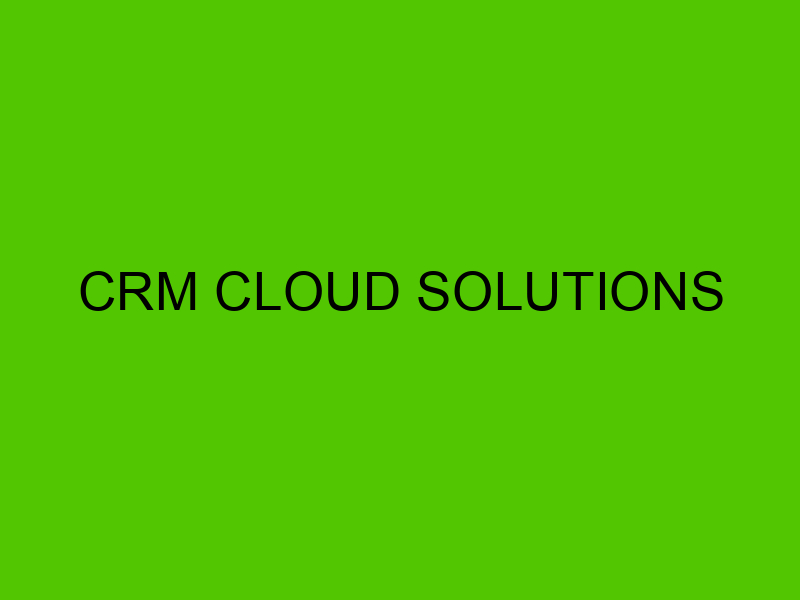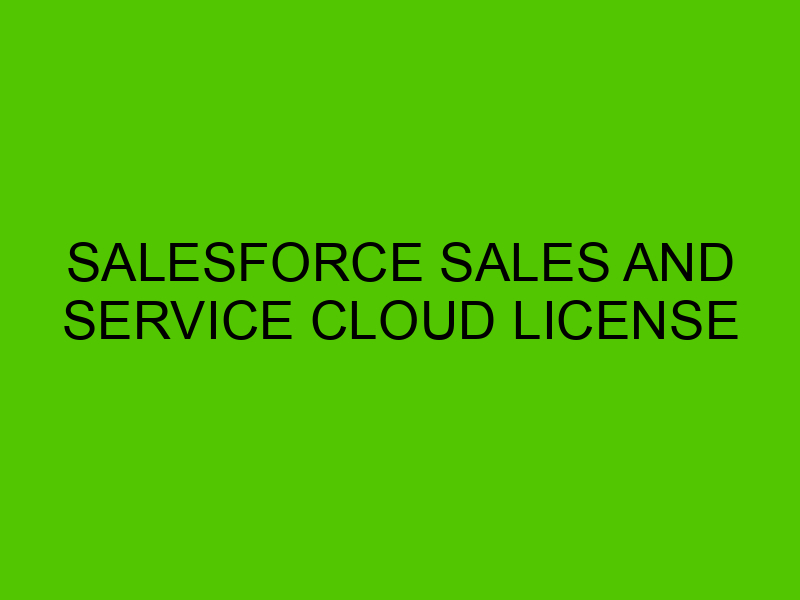CRM Tasks
Introduction: A Comprehensive Guide to CRM Tasks
Customer Relationship Management (CRM) is an important business strategy that involves managing interactions with customers to improve business relationships and foster customer loyalty. By implementing CRM tasks, businesses can streamline their sales processes, increase customer retention rates, and ultimately boost revenue. In this article, we will explore the essential CRM tasks that every business needs to handle to achieve success.
1. Data Management
One of the most critical CRM tasks that businesses need to handle is data management. The goal of data management is to ensure that all customer data is accurately recorded, organized, and easily accessible. By maintaining a unified database that contains all customer information, businesses can gain insight into customer behaviors and preferences, allowing them to make informed decisions about their marketing strategy and product offerings.
There are several CRM tasks that fall under the umbrella of data management, including:
Data Collection
The first step in data management is collecting customer data. Businesses can collect data from a variety of sources, including social media, online forms, and in-person interactions. It’s essential to ensure that all data collected is accurate and up-to-date to avoid any errors or discrepancies in the database.
Data Cleaning
Once the data is collected, it’s crucial to clean it up. Data cleaning involves removing duplicate data, correcting errors, and standardizing data formats. This ensures that the database is consistent and accurate, making it easier to extract insights for decision-making.
Data Integration
Businesses often have data stored in multiple places, such as marketing automation software, customer service software, sales CRM, and other databases. Data integration involves consolidating all the disparate data into a unified database, allowing businesses to gain a complete view of their customers.
Data Analysis
After the data is organized and cleaned up, businesses can analyze it to gain insights into customer behaviors and preferences. Data analysis helps businesses create targeted marketing campaigns and personalized product offerings, which in turn can improve customer engagement and increase sales.
Overall, effective data management is crucial for businesses to implement effective CRM strategies. By implementing the CRM tasks mentioned above, businesses can ensure that their customer data is accurate, reliable, and easily accessible.
Customer Data Management
Effective customer data management is one of the most critical tasks in managing customer relationships. It involves the collection, storage, and analysis of customer data to improve the quality of customer interactions, deepen relationships, and drive business growth. In today’s digital age, businesses are generating large volumes of data daily, making it more crucial to manage it effectively. The following are some of the key ways to effectively manage customer data:
Data Collection
The first step in effective customer data management is collecting the data. Different businesses use different methods to collect data, depending on their customer interaction channels, such as online forms, surveys, or in-store purchases. It is important to ensure that the data collected is accurate, relevant, and up-to-date.
Data Storage
Once the data is collected, it needs to be stored securely. The use of modern technology and software for storing customer data helps organize, secure, and efficiently manage it. When choosing a storage system, businesses should consider the ease of access, the ability to manage different types of data, and the system’s scalability.
Data Analysis
After collecting and storing the data, the next critical step is analyzing it to draw insights that can help improve business operations. Businesses can use data analytics software to analyze customer data, drawing inferences that can improve marketing and sales efforts. For example, a retail store can use customer data to group them based on frequently purchased products and customer preferences. In turn, the business can create targeted campaigns that increase sales by providing personalized and relevant products to each group.
Data Maintenance
Customer data changes regularly, and it is essential to provide timely updates to ensure that the data is accurate and useful. Data quality management should be a priority to avoid the accumulation of outdated or incorrect information. Automated data cleansing and validation tools can be used to ensure data quality.
Data Privacy
Finally, with the growing concern of data privacy, businesses should ensure that they handle data ethically, protect customer data against external threats, and comply with regulatory requirements. This includes obtaining consent before collecting customer data, implementing data encryption, and following data retention policies. A data breach can impact customer trust and lead to legal repercussions.
In conclusion, effective customer data management is critical in CRM, and businesses must continuously evaluate the effectiveness of their data management processes and make improvements where necessary. Better customer data management translates into better customer experiences and improved business outcomes.
Lead Management
Organizing your customer data is just the beginning. What’s the point of collecting data if you don’t know what to do with it? This is where managing leads comes in. You want to take those potential customers and turn them into loyal, paying customers. In order to do that, you need to track them and move them through the sales funnel.
The sales funnel is a metaphor for the customer journey. It includes different stages, such as awareness, interest, consideration, intent, and finally, purchase. Each stage is important because it represents a different level of commitment from the potential customer. Someone who is just aware of your brand is less likely to buy than someone who has already expressed an intent to purchase.
Your job as a CRM manager is to guide these potential customers through the funnel. You want to make sure they don’t get stuck at one stage and abandon the process altogether. Here are some tips on how to manage leads effectively:
1. Qualify leads
Not all leads are created equal. Some are more likely to buy than others. You want to focus your efforts on those who are most likely to convert. This is where lead qualification comes in. You can use different criteria to determine whether a lead is worth pursuing or not. For example, you can look at their demographics, their behavior on your website, or their past interactions with your brand. Once you have a pool of qualified leads, you can start targeting them with personalized messages and offers.
2. Nurture leads
Just because someone is not ready to buy right now doesn’t mean they won’t be in the future. In fact, most leads require multiple touchpoints before they convert. This is where lead nurturing comes in. You want to stay top of mind with your leads by providing them with relevant and valuable content. This can be in the form of email newsletters, blog posts, social media updates, or personalized recommendations. The goal is to build trust and authority with your leads so that when they are ready to buy, they think of you first.
3. Monitor and optimize your funnel
A sales funnel is not a one-size-fits-all concept. Your funnel may look different from your competitor’s funnel, and that’s okay. What’s important is that you monitor and optimize your funnel regularly. This means tracking the performance of each stage and identifying areas for improvement. For example, if you notice that a lot of leads are dropping off at the consideration stage, you may need to adjust your messaging or offer. Or if you notice that a lot of leads are bouncing off your landing page, you may need to simplify your form or make your value proposition clearer. The goal is to constantly iterate and test until you find the funnel that works best for your business.
Managing leads is a crucial part of any CRM strategy. By qualifying, nurturing, and optimizing your leads, you can increase your chances of converting them into loyal, paying customers. Remember, customer data is only valuable if you know how to use it. Use your CRM platform to its fullest potential and watch your business grow.
Sales Forecasting and Reporting
One of the most crucial CRM tasks for businesses is sales forecasting and reporting. With the help of CRM platforms, businesses can gather all the necessary data on their sales to predict future sales and make informed business decisions. This not only helps businesses plan strategically but also allows them to stay ahead of their competition.
The use of CRM tools can help businesses keep track of their sales performance and identify the factors that affect their sales. By analyzing data such as past sales transactions, industry trends, customer behavior, and market conditions, businesses can predict their future sales growth and set sales goals. Businesses can also set realistic targets based on the data collected within the CRM platform.
Moreover, CRM platforms can also generate real-time reports that provide businesses with a comprehensive view of their sales performance. These reports can showcase important data such as revenue, sales trends, customer demographics, and sales team performance. By having this information at their fingertips, businesses can easily identify areas that need improvement and quickly create strategies to address these issues.
Another significant aspect of CRM sales forecasting and reporting is the ability to conduct a sales pipeline analysis. This allows businesses to analyze the entire sales process, identify sales bottlenecks, and predict sales revenue accurately. Businesses can use this information to manage their sales pipeline effectively, prioritize sales efforts, and allocate resources to improve their sales performance.
CRM platforms collect and analyze sales data to provide businesses with real-time insights into their sales performance. This allows businesses to make informed decisions, set realistic targets, and create effective strategies that will lead to improved sales growth.
In summary, CRM sales forecasting and reporting is essential for businesses that want to stay ahead of their competition and achieve sales growth targets. The ability to collect and analyze data, create real-time reports, conduct sales pipeline analysis and identify areas that need improvement easily will lead to improved sales performance and overall business success.
Customer Tracking and Engagement
It is crucial to track every interaction that customers have with your business to improve your customer engagement. This means keeping track of phone calls, email conversations, and social media engagements. If you can monitor each communication, you can better understand what your clients are looking for and how you can meet their needs. Moreover, it gives you the opportunity to measure their customer satisfaction, which is an essential aspect of building a successful business.
For many businesses, customer relationship management (CRM) software is an invaluable tool for capturing customer interactions from every channel. It enables centralizing the information that every department in your business needs, including sales, marketing, and customer service, among others. By taking a coordinated approach to tracking customer interactions, your business can enhance data accuracy and avoid duplication of efforts.
In addition to capturing customer interactions, you need to be engaging with customers regularly. If you don’t interact with them frequently, they may feel neglected, and their engagement may quickly decline. Engaging with your audience regularly can help you gain insights into their needs, preferences, and challenges. This, in return, can help you improve your product or service offering and create a positive user experience.
Ways to Engage with Customers
Engaging with customers means finding ways to interact with them on various platforms and creating an excellent user experience. There are various ways to engage customers, some of which include:
- Creating valuable content: Providing customers with blogs, newsletters, whitepapers, and other useful content helps you to maintain a connection with them over time.
- Responding promptly: Ensure you respond to customer queries as soon as possible, as this can help to build trust and improve your customer relationships.
- Personalization: Offering personalized experiences, such as customized messages, coupons, and experiences, can make your customer feel special and valued.
- Social media: Social media is a critical tool for customer engagement, as it provides a platform for customers to engage with your brand directly.
- Email marketing: Email marketing is another great tool for reaching out to customers. It helps you to personalize your messages and communicate with them effectively.
By leveraging these engagement strategies, you can build a long-lasting relationship with your customers and increase your customer retention rate.
Why Tracking Customer Engagement is Essential
Tracking customer engagement is critical for your business in many ways, some of which include:
- Improving customer experience: By tracking customer interactions, you can uncover pain points and improve your offerings to meet their needs.
- Building customer loyalty: By tracking customer engagement, you can identify and reward loyal customers, leading to increased retention and improved brand advocacy.
- Avoiding customer churn: Tracking engagement can help you predict when a customer might churn (stop using your product or service), enabling you to take action before it’s too late.
- Improving sales: By tracking customer engagement, you can identify upsell and cross-sell opportunities, leading to increased sales and revenue.
- Building your brand: By tracking customer engagement, you can improve brand sentiment, helping you to build a positive reputation in the market.
Overall, customer tracking and engagement are essential for maintaining a successful business. By leveraging CRM tools and engagement strategies, you can build long-lasting relationships with your customers, improve your offerings, and grow your business.
Automating Routine Tasks
Managing customer relationships is a vital aspect of running a business, and Customer Relationship Management (CRM) software makes it easier. Automating routine tasks, such as data entry, lead alerts, and managing the sales process, can simplify your CRM’s to-do checklist, giving you more time for strategic tasks.
Task automation streamlines workflow and helps businesses improve efficiency, productivity, and profitability. Automating routine tasks that consume too much time and energy can help businesses focus on more important tasks that can help retain and expand their customer base.
Here are six routine tasks that can be automated in your CRM:
1. Data Entry
Data entry is a repetitive task that is both time-consuming and prone to errors. Manually entering data into a CRM system is not only tedious but also runs the risk of incorrect data entry. One of the benefits of automation is that it eliminates the risk of human error in data entry. Automated data entry ensures that all information is entered promptly and accurately. This reduces the likelihood of errors, duplication, and inconsistencies in data.
2. Lead Alerts
Automated lead alerts help sales teams stay on top of new leads. Sales reps no longer need to manually monitor their CRM for new leads, which is overwhelming and time-consuming. An automated lead alert system sends notifications via email or text message to alert reps of new leads, allowing them to respond quickly and efficiently to potential clients.
3. Sales Process Management
Automating the sales process eliminates manual tasks such as creating quotes, fulfilling orders, and other crucial stages in the sales cycle. Automating the sales process also helps sales managers to track and monitor sales progress and provides crucial insights into pipeline analysis, dealing with sales slump, and identifying areas for improvement. By automating the sales process in a CRM, sales teams save time, reduce errors, and ensure a high level of consistency across all stages of the sales cycle.
4. Email Campaigns
An effective email campaign is a powerful tool for engaging leads and existing customers, building brand awareness, and increasing conversions. However, creating and managing email campaigns can be time-consuming, especially if you are doing it manually. An automated system for email campaigns significantly reduces the time and resources spent creating and sending them. With an automated CRM, emails can be created, personalized, and automated according to the customer’s actions and behavior in real-time. This helps to drive conversions and improve ROI.
5. Reports and Analysis
Generating reports and analyzing data are essential aspects of CRM operation. However, manual report generation and data analysis can be time-consuming and can lead to inaccuracies. Automating reports and analysis allows businesses to access real-time, accurate data to drive their business decisions. Automated reports can be scheduled to be generated and delivered at specific times, helping management and sales teams stay updated with crucial information.
6. Contact Segmentation
Contact segmentation is the process of grouping customers based on specific criteria such as location, industry, interests, or stage in the sales cycle. This allows businesses to create targeted marketing campaigns that resonate with specific customer groups. Manually segmenting leads and customers can be time-consuming and prone to errors. However, with an automated CRM, you can easily sort contacts and tailor your marketing strategy to specific groups, improving the effectiveness of your marketing efforts.
In conclusion, automating routine tasks in CRM helps streamline workflow, saving time, reducing errors, and improving efficiency. It also allows businesses to focus on more strategic tasks, such as building relationships with customers and expanding their customer base. With automation, businesses can make the most out of their CRM system, gaining insights that empower them to achieve business success.
1. Understanding the Importance of CRM Tasks
CRM (Customer Relationship Management) Tasks play a vital role in retaining customers, improving customer satisfaction, and augmenting business growth. When businesses aim to be successful, customer retention is an essential aspect that shouldn’t be taken lightly. Following CRM tasks help businesses to stay connected with their customers regularly, leading to healthy customer relationships.
CRM tasks include managing customer information, analyzing customer data, managing leads, monitoring sales processes, evaluating campaign results, tracking customer activity, and ensuring timely follow-ups. By handling these tasks efficiently, businesses can foster better communication with customers, gain their loyalty, and earn a positive business reputation.
2. The Benefits of Effective CRM Tasks
When businesses effectively manage their CRM tasks, they reap numerous benefits. Efficient CRM tasks reduce customer churn rates, increase customer satisfaction levels, and generate positive word-of-mouth marketing for businesses. When businesses have an extensive database of customer information, they can create personalized customer experiences, understand their customers’ needs, and tailor their offerings accordingly.
Moreover, with effective CRM tasks, businesses can identify potential upselling and cross-selling opportunities, nurture leads into potential customers, and streamline their sales processes. This leads to better productivity, increased profitability, and maximized business growth.
3. Tips to Efficiently Handle CRM Tasks
Efficiently managing CRM tasks requires businesses to adopt certain tactics. Companies need to have a dedicated team that ensures continuous customer engagement. They need to keep track of customer interactions, including calls, chats, emails, social media interactions, and website visits. They should have a centralized database that holds all customer information, including their purchase history and communication preferences.
Furthermore, businesses should adopt automation tools that help manage tasks, such as follow-up schedules and appointment reminders. They also need to monitor campaign results regularly and analyze customer data to understand patterns and preferences. Automating these tasks reduces manual workloads, increases accuracy, and saves time.
4. The Role of Technology in Managing CRM Tasks
Technology plays an essential role in effective CRM task management. Many software solutions help companies monitor customer interactions, track leads, analyze data, automate tasks, and provide real-time customer support. CRM software provides a centralized database that holds all customer interactions and information, making it easier for companies to access and manage data.
Moreover, businesses can leverage Artificial Intelligence (AI) and Machine Learning (ML) technologies to make better data-driven decisions, personalize customer experiences, and automate tasks further. With AI-powered chatbots, businesses can provide 24/7 customer support, increase customer satisfaction levels, and reduce response times.
5. Common Pitfalls to Avoid in CRM Tasks
Efficiently managing CRM tasks is an ongoing process that requires businesses to avoid certain pitfalls. One of these pitfalls is not having a dedicated team responsible for CRM tasks. Not assigning adequate resources to handle these tasks reduces customer engagement and negatively impacts business growth. Moreover, businesses should avoid overselling to customers, being too pushy with sales, or sending irrelevant marketing messages, damaging customer relationships.
Another pitfall is not analyzing customer data regularly, leading to missed opportunities for growth and customer retention. Lastly, ignoring customer feedback or failing to implement their suggestions can cause customers to churn.
6. Strategies to Improve Customer Engagement Through CRM Tasks
Customer engagement is critical to build long-lasting relationships with customers. Effective CRM tasks enable businesses to improve customer engagement and create positive customer experiences. One way to improve customer engagement is to create personalized experiences. By leveraging customer data, businesses can offer personalized recommendations, promotions and provide personalized support.
Another way is to provide omni-channel support. In other words, businesses should provide support through various channels, including social media, chatbots, email, and phone. This ensures that customers can reach out to businesses through their preferred channels, ultimately increasing engagement levels.
7. Conclusion
CRM tasks play a vital role in retaining customers, improving satisfaction levels, and accelerating business growth. By adapting to technology, effectively managing CRM tasks, and avoiding common pitfalls, businesses can improve customer engagement and create positive customer experiences. It is essential to dedicate ample resources to handle CRM tasks, regular analyze data, and implement strategies that improve customer engagement. Ultimately, businesses that prioritize CRM tasks will gain a competitive edge, build a positive business reputation, and foster long-lasting customer relationships.










